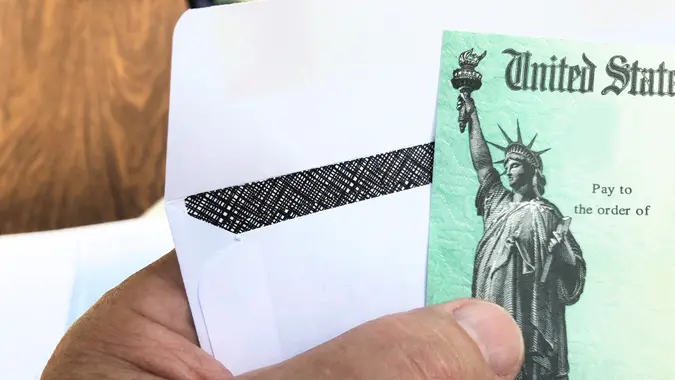How Does a 401(k) Match Work? A Simple Guide

Commitment to Our Readers
GOBankingRates' editorial team is committed to bringing you unbiased reviews and information. We use data-driven methodologies to evaluate financial products and services - our reviews and ratings are not influenced by advertisers. You can read more about our editorial guidelines and our products and services review methodology.

20 Years
Helping You Live Richer

Reviewed
by Experts

Trusted by
Millions of Readers
A 401(k) match is when your employer contributes money to your 401(k) account based on how much you are contributing. Companies can structure their 401(k) matches differently.
Types of 401(k) Matching Contributions
Here are some common variations.
- Full match: The employer matches the employee’s contributions on a dollar-for-dollar basis up to a set amount, often 4% to 6% of the worker’s income.
- Partial match: The company matches a portion of each dollar, often contributing $0.50 for every dollar the employee saves.
- Discretionary match: Also called flat-rate match, this format pays a set dollar amount — e.g., $5,000 per year — to all participating employees regardless of their earnings or contributions.
- Tiered match: This is a combination of the full and partial match. The company might match 100% of the first 3% of contributions and 50% of that last percent.
There are also several different formulas that companies use when applying their chosen matching structure to their employee’s 401(k)s.
How to Maximize Your 401(k) Match
Your full 401(k) match gives you free money. Get the most out of your retirement plan by following these steps.
- Read the terms of your plan to find out the maximum amount your employer will match.
- Set up automated payroll withholding.
- Set your withholdings to at least the percentage of your income that your employer matches.
- Make consistent contributions every pay period or schedule them to sync with your employer’s matching schedule.
- Increase your contributions to meet the match with every pay raise, no matter how modest.
Vesting and 401(k) Matches
Your vested 401(k) contributions are the ones you own. If you change jobs, you own all of your contributions and any gains they earn. However, many employers don’t grant employees ownership of their matching contributions until they’ve been on with the company for a set amount of time.
The process is called vesting, which can take several forms: immediate, graded and cliff vesting.
Immediate Vesting
This is the most simple vesting schedule. The employee fully owns all of the employer contributions and their own contributions right away.
Graded Vesting
With graded vesting, the company gradually gives the employee ownership in their contributions until the employee is fully vested and owns 100% of both their contributions and the company match.
The IRS offers the following example:
| Years of Service | Percentage Vested |
|---|---|
| 1 | 0% |
| 2 | 20% |
| 3 | 40% |
| 4 | 60% |
| 5 | 80% |
| 6 | 100% |
Cliff Vesting
Cliff vesting is an all-or-nothing format that gives the company 100% ownership of its employer match and then transfers all of it — leaving the employee fully vested — after a set time.
| Years of Service | Percentage Vested |
|---|---|
| 1 | 0% |
| 2 | 0% |
| 3 | 100% |
What Happens If You Don’t Contribute Enough to Get the Full Match?
Two or three percentage points might not sound like a lot, but with time, the power of compounding can turn a little into a lot — and missing the full match can have six- or even seven-figure consequences down the line.
Imagine your employer offers a 100% match of up to 5%. If you contribute the minimum to get the match, you’ll be able to double your retirement contributions each year.
401(k) Match Rules and Limits
IRS rules govern how both employees and employers must handle 401(k) plans and any matching contributions:
- No employer can require employees to serve for more than one year before they become eligible to participate in a company 401(k).
- Employee contributions are limited to $23,500 for 2025, but matching company contributions don’t count toward this maximum.
- Catch-up contributions for employees 50 and up are limited to $7,500.
- Total combined employee and employer contributions must not exceed the lesser of $70,000 or 100% of the employee’s compensation.
- For 2025, employers must consider income up to $350,000 when calculating contributions.
Should You Contribute to a 401(k) Match?
Unless you have a rich and generous uncle, free money is not easy to come by — unless your employer offers a 401(k) with a company match.
Given enough time, even modest earners can grow seven-figure nest eggs if they utilize employer contributions, which is why nearly all credible experts advise taking full advantage of 401(k) matching as one of the most powerful wealth-building tools available.
Our in-house research team and on-site financial experts work together to create content that’s accurate, impartial, and up to date. We fact-check every single statistic, quote and fact using trusted primary resources to make sure the information we provide is correct. You can learn more about GOBankingRates’ processes and standards in our editorial policy.
 Written by
Written by  Edited by
Edited by 

























